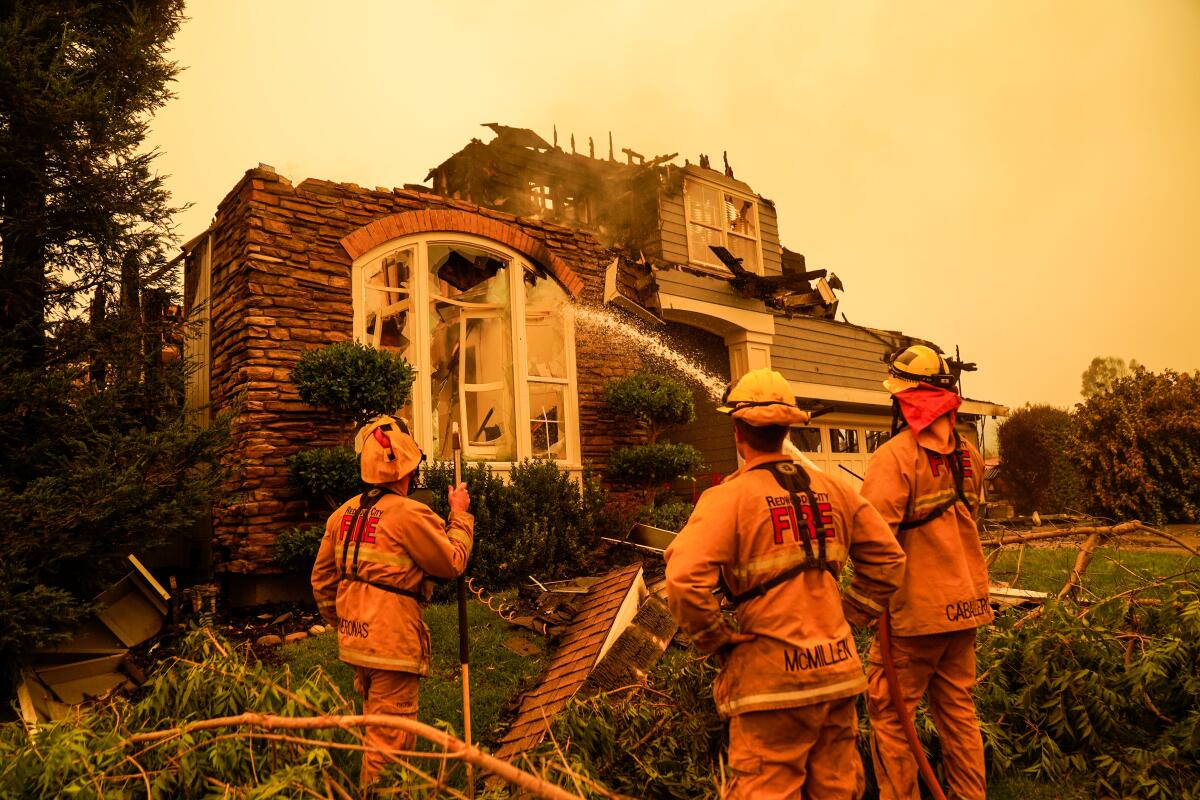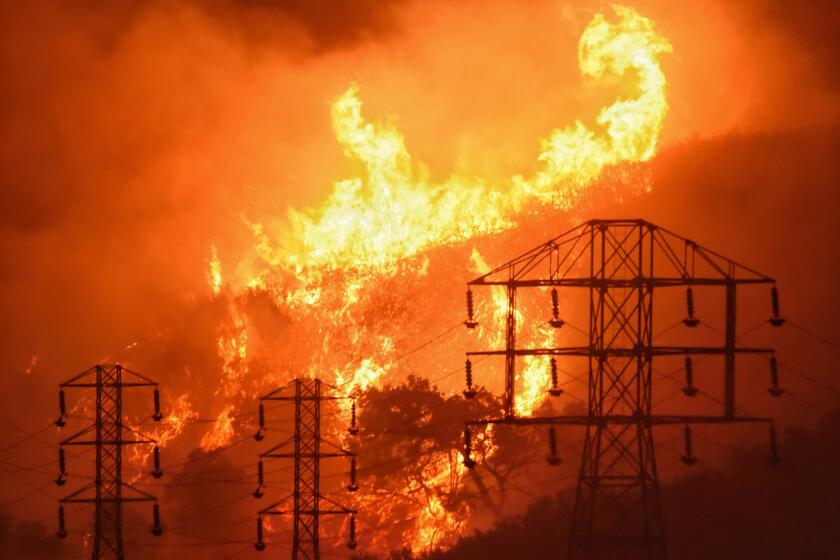With lessons learned from deadly wildfires, Sonoma County improves evacuation planning

- Share via
When wildfire evacuations were ordered in and around Santa Rosa recently, the smoke and chaos reminded many of the terrible firestorm that had killed dozens of people and destroyed thousands of homes three years earlier.
But unlike that earlier fire — when first responders were overwhelmed and emergency officials were hesitant to order evacuations — this year was different. Emergency information was broadcast via TV, radio and the internet. Many cellphones buzzed and beeped, while sirens blared and police darted door to door knocking and shouting for residents to get out.
Though damage from the Glass fire is still being assessed, it is clear that during its night run Sept. 27, fewer homes were destroyed compared with the 2017 firestorm. And, more significant, nobody was killed. Though less severe fire conditions certainly played a role — the blaze started earlier in the evening with winds topping out at 65 mph instead of more than 80 mph in 2017 — officials say the community’s preparedness was also key in things running more smoothly.
“Sonoma County — literally trial by fire,” said Susan Gorin, the county chair and 1st District supervisor, who lost her Oakmont home in the 2017 Tubbs fire. “We are seasoned and eager to share our expertise and information.”
One key to getting through any emergency situation is preparation.
The toll of the natural disasters that struck California in 2017 and 2018 was staggering. In just 14 months, multiple wildfires and a mudslide killed more than 150 people, destroyed more than 30,000 homes and businesses, bankrupted California’s biggest utility and sparked more than $30 billion in insurance claims, forcing at least one insurer to go under.
But it also forced California to reassess its laissez-faire approach to local emergency response and to put forward a set of standardized guidelines that communities could adopt to streamline their preparations and response when emergencies blend across jurisdictions. Sonoma County has taken several of those guidelines to heart and used them recently when the Glass fire approached, said its director of emergency management, Christopher Godley.
“When it came in, it met a county that was better prepared,” Godley said.
Sonoma County’s response began before the fire was even reported. With red flag conditions forecast for the last weekend in September, county firefighters divided themselves into strike teams so they could be deployed in preset groups as soon as a rapidly growing fire was reported.
The county’s Emergency Management Department, with four to five full-time employees and an $850,000 budget in 2017, now has 11 full-time workers and operates with $2.4 million in county funds and grants, Godley said. The department is also staffed by at least one person 24 hours a day and has more workers trained on how to write and send out emergency alerts to the public — which was a communications bottleneck three years ago.
Also, the county had already identified senior care living facilities full of vulnerable residents, so the city of Santa Rosa sent shuttle buses into the evacuation zone to help get residents out when the evacuation orders came, Godley said. Traffic backed up on Highway 12 for more than an hour as the evacuations unfolded, but it eventually cleared, officials said.
“This isn’t our first rodeo experiencing this, and I think everyone now understands we have to work together to evacuate safely and effectively,” Santa Rosa Mayor Tom Schwedhelm said during a recent community update that included a sign-language interpreter.
Remote weather stations, satellites and supercomputers have begun to show promise as a means of predicting the spread of wildfires.
Counties have traditionally overlooked non-English speaking and other marginalized communities in their emergency planning and response. Sonoma County’s alert page now includes a Spanish-language version; regardless, community advocates say, there is still more outreach work to be done.
Once the fire was reported, other aspects of the county’s updated response rolled out, Godley said. The emergency operations center was up and running within an hour, along with the first messages to foothill and isolated residents to pack up and either get ready to leave or just flat-out go. Because the county had already broken up Santa Rosa and surrounding areas into evacuation zones, officials could quickly pick areas to alert instead of having to carve out their targets street by street.
Despite the area’s recent history of fires, including the massive Kincade fire that threatened communities for weeks last year, some residents still refused to heed evacuation orders and had to be rescued or shuttled out later by ambulance, officials said.
“The rugged individualist that may be living at the end or middle of a very windy road for generations, they’re the folks that think they can stay to fight the fires and some sadly perish,” Gorin said.
In general, more people heeded evacuation orders for the Glass fire than used to, city and county officials said.
“It’s a new realization that the fires we had even 20 years ago are not the fires that we have today. You have to proclaim very loudly and publicly, ‘It’s time to get out now,’” Gorin said.
Two residents, on the other hand, emailed the Federal Communications Commission, complaining about the lack of clarity in the county’s emergency broadcast that interrupted their TV programming. The messages were unclear, they said, and the automated voice reading out instructions was fuzzy.
Many of the critiques should have been directed to the person’s cable provider or can be attributed to FCC rules surrounding emergency messaging, the agency replied to the residents in an email.
“Overall,” one FCC email to a resident read, “it appears Sonoma County issued 19 warning messages last night without a single error or failure. That is quite an impressive effort.”
For comparison, when Napa County attempted to send out an Amber Alert-style wireless emergency notice to its residents last month during a wildfire, the message initially failed and had to be sent out through other means.
Overall, the changes within Sonoma County since 2017 underline a broader conversation happening within emergency management about the need for a more independent role in policymaking, as opposed to being a line item in a police or fire department budget.
In March, for example, Los Angeles County removed Sheriff Alex Villanueva as the head of its emergency operations center, citing a recommendation in an after-action report following the 2018 Woolsey fire.
“People are taking notice,” Godley said. “Fifteen years ago, we were looking for a tipping point when this would become part of the mainstream consciousness. I didn’t think it would happen until 2030, but clearly this fire, flooding events and extreme weather has pushed it to the forefront here in California.”
More to Read
Sign up for Essential California
The most important California stories and recommendations in your inbox every morning.
You may occasionally receive promotional content from the Los Angeles Times.
















